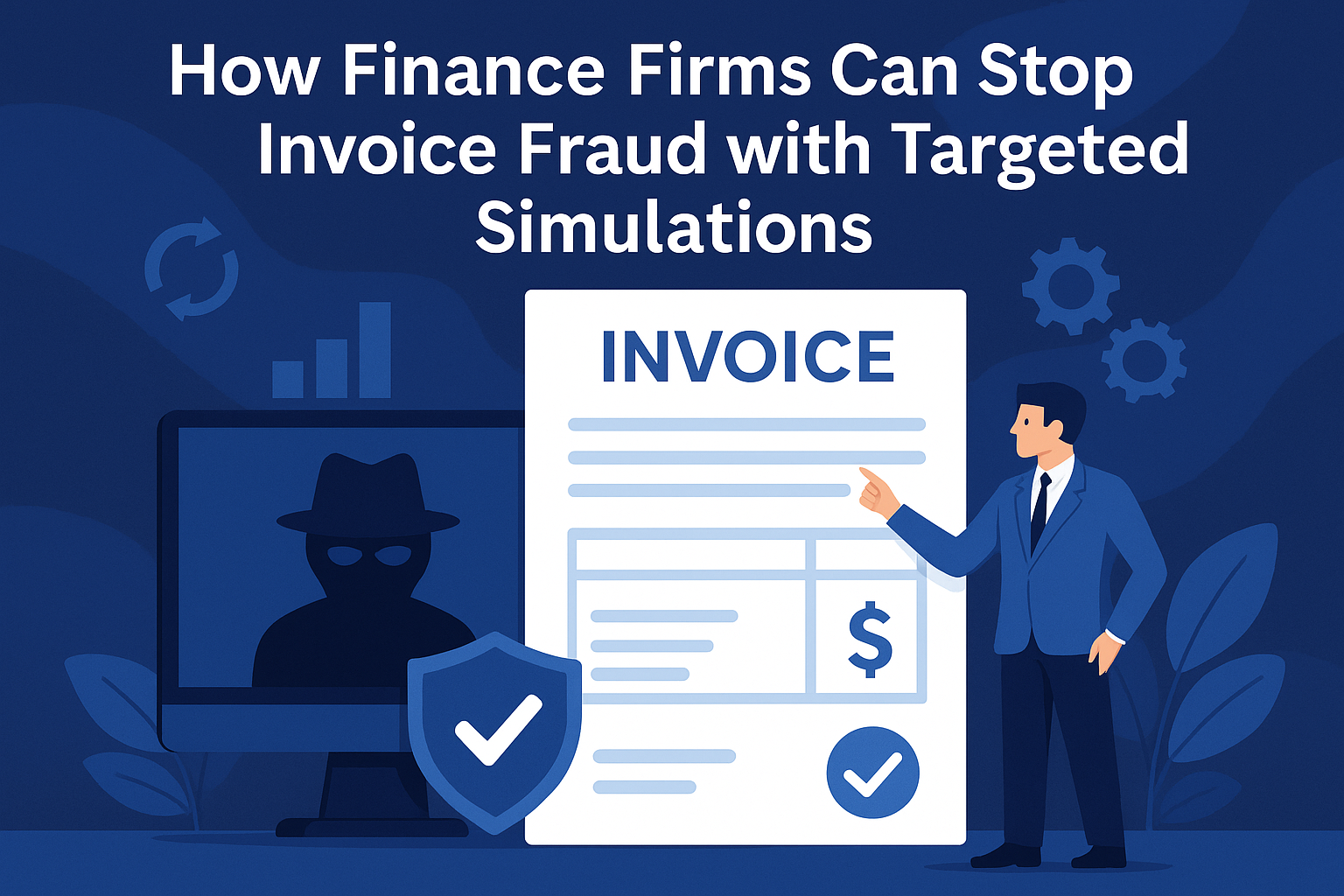Business
How Finance Firms Can Stop Invoice Fraud with Targeted Simulations

Invoice fraud is one of the most financially devastating — and yet preventable — cyber threats plaguing finance firms today. In a world where a single misplaced trust or unverified payment request can cost millions, financial institutions are realizing that technology alone cannot stop these attacks. What’s needed is a well-calibrated human defense: employees who can spot deception before it costs the organization.
That’s where targeted phishing simulations come in — and why platforms like ClearPhish are changing how financial institutions defend against social engineering and invoice fraud.
The Alarming Rise of Invoice Fraud in Finance
Invoice fraud occurs when attackers trick employees — typically in finance, procurement, or accounts payable — into making unauthorized payments. This can involve fake invoices, supplier impersonation, or business email compromise (BEC) tactics that mimic legitimate correspondence.
According to the FBI’s Internet Crime Complaint Center (IC3), BEC attacks led to over $2.9 billion in losses in 2024, with invoice fraud being one of the most common forms. The financial sector, due to its high transaction volume and trust-based workflows, is especially vulnerable.
Real-world examples paint a clear picture:
- Ubiquiti Networks (2021) — The tech firm lost over $46 million after fraudsters impersonated company executives and requested wire transfers to overseas accounts.
- Leoni AG (2016) — The German cable manufacturer lost €40 million to a CEO fraud scam where attackers sent spoofed invoices.
- Facebook and Google (2013–2015) — Even tech giants aren’t immune; both companies were tricked out of $100 million through fake invoices from a Lithuanian fraudster posing as a supplier.
While these examples span industries, financial organizations face a unique challenge: they process vast volumes of invoices and transfers daily, leaving little room for verification delays.
Why Traditional Defenses Fall Short
Most finance firms already have multiple layers of defense: email filters, payment verification policies, and even mandatory two-person approvals for wire transfers. Yet invoice fraud still slips through. Why?
1. Attackers exploit human trust.
Fraudsters don’t need to breach systems — they breach minds. A well-crafted email from a “known” vendor or executive, especially under time pressure, bypasses even the most robust technical filters.
2. One-size-fits-all training doesn’t work.
Generic phishing awareness modules or once-a-year seminars fail to simulate the pressure, urgency, and emotional manipulation that accompany real invoice fraud attempts.
3. No feedback loop.
Most training programs lack contextual learning — employees aren’t shown why they fell for a simulated attack, or how their specific behavior exposed the organization.
This is where targeted phishing simulations offer a crucial advantage. Instead of broad awareness campaigns, they create role-specific, contextual, and realistic scenarios that mirror actual fraud attempts.
How Targeted Simulations Work Against Invoice Fraud
A targeted phishing simulation is not just an email test — it’s a behavioral experiment designed to evaluate and strengthen how specific teams react to deception.
For financial institutions, this means creating simulation campaigns that mimic the exact fraud patterns seen in the real world. For example:
- Vendor Spoofing: An email from a known supplier domain (with a subtle misspelling) requesting payment for a new invoice.
- Executive Impersonation: A “CFO” email instructing an urgent transfer ahead of an audit deadline.
- Payment Diversion: A message claiming a vendor has changed banking details and providing “updated” account numbers.
- Internal Collaboration Fraud: A fake internal request from procurement to approve a vendor payment.
By running these simulations in controlled environments, firms can observe how their teams respond, measure vulnerabilities, and reinforce learning through immediate feedback and micro-lessons.
Case in Point: How a Mid-Sized Investment Firm Cut Its Fraud Risk
Consider the case of a mid-sized investment management firm in Singapore. After suffering an attempted invoice fraud that was only caught due to a vigilant junior accountant, the firm decided to conduct department-specific phishing simulations.
ClearPhish was deployed to run a series of targeted simulations across the finance and procurement departments. These simulations included:
- Hyper-realistic vendor emails with cloned branding and invoice attachments.
- Scenario-based stress triggers (e.g., end-of-quarter payment deadlines).
- Follow-up awareness modules that explained emotional manipulation tactics.
Within three months, the firm’s phishing susceptibility rate dropped from 38% to under 10%, and employees began proactively verifying payment instructions through secondary channels. More importantly, finance executives developed a deeper understanding of how social engineering operates under business pressure.
The ClearPhish Approach: Precision Simulations with Measurable Outcomes
At ClearPhish, we believe that traditional “spray-and-pray” simulations are obsolete. Invoice fraud is not a generic problem — it’s a targeted, high-stakes manipulation that must be countered with equal precision.
Here’s how ClearPhish enables finance firms to do that effectively:
1. Role-Based Simulation Design
Finance teams face different threats than marketing or HR. ClearPhish builds simulations around the exact workflows of finance teams — invoice approvals, payment authorizations, and vendor communications — ensuring every test feels real and relevant.
2. Emotional Vulnerability Index (EVI) Scoring
ClearPhish uniquely measures the emotional triggers that lead to failure — urgency, authority bias, or trust in brand familiarity. This index helps firms understand not just who clicked, but why they did.
3. Adaptive Learning Feedback
Every simulated interaction provides instant, personalized feedback. Employees receive short, cinematic awareness modules that reinforce lessons while maintaining engagement.
4. Scalable Automation
For large financial institutions managing thousands of employees and multiple subsidiaries, ClearPhish automates campaign orchestration, scheduling, and reporting — ensuring continuous protection without administrative overhead.
5. Integration with Incident Response
Simulation insights can feed into security operations, helping SOC teams prioritize real threats based on behavioral data gathered during simulations.
Beyond Training: Building a Culture of Verification
The end goal of phishing simulations isn’t to catch employees off guard — it’s to normalize verification as a reflex.
Finance professionals must feel comfortable questioning even legitimate-looking requests, especially when money is involved. Some of the most secure firms have adopted “Trust, then Verify” cultures where no payment instruction is above scrutiny.
ClearPhish fosters this mindset by combining simulation data with behavior analytics, helping leadership identify departments that may require policy reinforcement or additional awareness campaigns.
The ROI of Prevention
The financial cost of invoice fraud can be staggering — not just in direct losses, but also in reputation damage, compliance failures, and customer trust erosion. According to Deloitte’s 2025 Global Financial Crime Survey, the average recovery rate for invoice fraud losses is less than 12%.
By contrast, targeted phishing simulations cost a fraction of what a single incident can cause and can reduce susceptibility rates by up to 80% within six months when combined with behavioral reinforcement.
Conclusion: Targeted Defense for a Targeted Threat
Invoice fraud is not a technical problem — it’s a psychological one. Attackers exploit patterns of trust and routine that are deeply embedded in financial operations. The solution must therefore be psychological too — built on awareness, habit change, and behavioral insight.
ClearPhish empowers finance firms to simulate these real-world deceptions safely, measure emotional and procedural vulnerabilities, and transform employees from the weakest link into the strongest line of defense.
In the fight against invoice fraud, knowledge isn’t just power — it’s protection.
-

 Tech1 year ago
Tech1 year agoHow to Use a Temporary Number for WhatsApp
-

 Business2 years ago
Business2 years agoSepatuindonesia.com | Best Online Store in Indonesia
-

 Social Media1 year ago
Social Media1 year agoThe Best Methods to Download TikTok Videos Using SnapTik
-

 Technology1 year ago
Technology1 year agoTop High Paying Affiliate Programs
-

 Tech10 months ago
Tech10 months agoUnderstanding thejavasea.me Leaks Aio-TLP: A Comprehensive Guide
-

 FOOD1 year ago
FOOD1 year agoHow to Identify Pure Desi Ghee? Ultimate Guidelines for Purchasing Authentic Ghee Online
-

 Instagram3 years ago
Instagram3 years agoFree Instagram Auto Follower Without Login
-

 Instagram3 years ago
Instagram3 years agoFree Instagram Follower Without Login




















